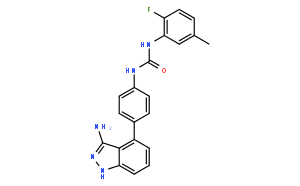| Description |
Linifanib (ABT-869) is a novel, potent ATP-competitive VEGFR/PDGFR inhibitor for KDR, CSF-1R, Flt-1/3 and PDGFRβ with IC50 of 4 nM, 3 nM, 3 nM/4 nM and 66 nM respectively, mostly effective in mutant kinase-dependent cancer cells (i.e. FLT3). Phase 3. |
| In vitro |
Linifanib shows inhibitory to Kit, PDGFRβ and Flt4 with IC50 of 14 nM, 66 nM and 190 nM in kinases assay. Linifanib also inhibits ligand-induced KDR, PDGFRβ, Kit, and CSF-1R phosphorylation with IC50 of 2 nM, 2 nM, 31 nM and 10 nM at cellular level and this cellular potency could be affected by serum protein. Linifanib suppresses VEGF-stimulated HUAEC proliferation with IC50 of 0.2 nM. While Linifanib has weak activity against tumor cells which are not induced by VEGF or PDGF, except for MV4-11 leukemia cells (with constitutively active form of Flt3) with IC50 of 4 nM. Linifanib could cause a decrease in S and G2-M phases with a corresponding increase in the sub-G0-G1 apoptotic population in MV4-11 cells. [1] Linifanib binds to the ATP-binding site of CSF-1R with Ki of 3 nM. [2] Linifanib (10 nM) exhibits a reduced phosphorylation of Akt at Ser473 and decreased phosphorylation of GSK3βat Ser9 in Ba/F3 FLT3 ITD cell lines. [3]
|

 COA
COA MSDS
MSDS HPLC
HPLC NMR
NMR